Niantic’s follow-up to the absurdly popular Pokémon GO, the long-awaited Harry Potter: Wizards Unite, has one major drawback: unlike its predecessor, you can’t explain it in a single sentence. There’s so much to do in this game that it may repel some casual players — but while its depths of systems and collectibles may be nigh endless, don’t worry: you still basically just walk around doing wizard and witch stuff.
I got to spend a short time playing the game at Niantic’s office in San Francisco, and while they didn’t reveal all their secrets, I saw enough to convince me that HP:WU (I await a catchier nickname, like PoGO) will be a huge time sink for any Harry Potter fan and will probably convert or cannibalize many players from GO.
If you were worried this would be a slapdash cash-in effort like some of the HP tie-ins we’ve seen… don’t be. This is legit. Rowling isn’t involved, and the voice actors are sound-alikes, but still legit.
And just to get some of the major facts out of the way before we move on: it’s coming out sometime in 2019 (I’d guess before Summer but they wouldn’t say), in 17 languages (listed at bottom; actual countries where it’ll be offered unknown), there’s no wand accessory yet (I asked and they all looked nervous), minimum specs are reasonable and AR is optional, and it’s free but there are in-app purchases.
So what is this game? While it would be misleading to say it’s just HP:GO, the similarities are deep. But there’s a lot more going on. Perhaps I’d best summarize it in bullet point form before I embark on the many details. In HP:WU you:
- Walk around a wizarding-themed version of the real world looking for locations at which to resupply and “foundables” to encounter
- Dispel, battle, or otherwise deal with the “confoundable” associated with these
- Earn reward items from encounters and for entering foundables in your registry
- Use reward items to level up in various professions, brew potions, and battle alongside others at “fortresses”
- Find rare foundables that advance the overall plot of why this is all happening anyway
So let’s take that piece by piece.
(By the way: The few images I have here were provided by Niantic and Portkey Games, the studio under WB Games who co-developed the game; I actually saw much more than what the shots show, so if something I describe isn’t illustrated directly, don’t worry — it’s in there.)
Walkable Wizarding World
“For Harry Potter fans, the line between the real world and the wizarding world is paper thin,” said WB Games’s Jonathan Knight. So they wanted to make it seem like, as with the pervasive hidden nooks and secrets of the HP world, “magic is all around you.”
The plot that enables all this is that, in a post-Deathly Hallows HP world, a macguffin event has caused magical items and creatures to appear all over the muggle world, threatening to expose the existence of magic; Witches and wizards are being recruited to track these things down and deal with them.
Conveniently, the event snatched these things and people from all throughout history and the world, laying them down willy-nilly — so you’re just as likely to find Fleur Delacoeur as Hermione Granger, or a young Dumbledore as an old one.
As a member of the SOS squad (enforcing the “Statute Of Secrecy” mandating separation between the magic and muggle worlds, you know), you’re tasked with tracking down these various things wherever they appear and reporting back to the ministry.
The map is, like in Pokémon GO, where you’ll be spending most of your time.
As before, it reflects the streets and features nearby: streets, parks, landmarks, and so on. It’s decidedly busier this time, however, both with gameplay elements and set dressing. Brooms and owls zip overhead, potion ingredients clutter the ground around you, and locations to visit sprinkle every block. (Although I’d hoped they’d use the Marauder’s Map aesthetic, they were probably right not to: it would probably get old fast.)
You interact with these locations as you would spin Pokéstops in GO, with “inns” and “greenhouses” giving you a semi-randomized reward every time (and starting a 5-minute cooldown). Encounters and ingredients pop up like Pokémon did, appearing semi-randomly but with some tendencies or affinities — for example, you’re more likely to find school-related foundables by actual schools, and so on. These places are helpfully noted by a little flag that highlights the affected area, such as: “Golden Gate Park – you’ll encounter more magical creatures here.”
The equivalent to lures are “dark detectors,” which will cause encounters to pop up with more frequency around the location you attach it to — and you can stack them! These will no doubt be a popular purchase.
One nice touch: when you move quickly, your character flies on a broom. No more “running” along the highway. That always did bug me.
Of course you’ll also be able to customize your appearance, and you even get to make a (non-public) “wizarding passport” complete with a moving photo you can outfit with various AR props. Your Hogwarts house is just something you select and which has no gameplay effect — for now.
Swish and flick
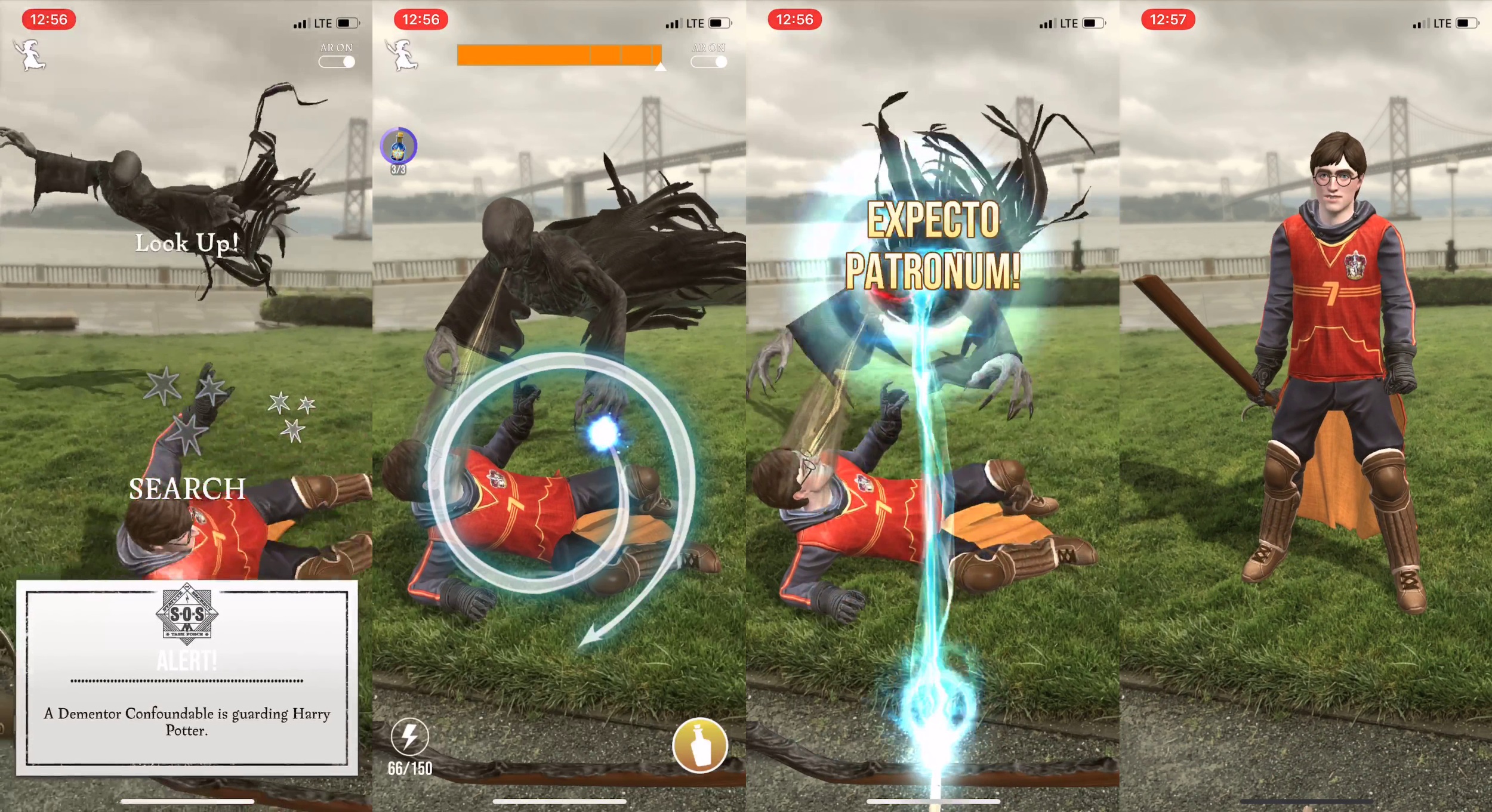 When you tap an encounter, you enter an AR minigame where you may, for instance, have to cast a spell to free Buckbeak the gryphon from a magical ball and chain, or defeat a monster threatening a character from the books.
When you tap an encounter, you enter an AR minigame where you may, for instance, have to cast a spell to free Buckbeak the gryphon from a magical ball and chain, or defeat a monster threatening a character from the books.
You do this generally by tracing a shape with your finger on the screen to cast a spell. You don’t get to choose the spell, unfortunately, it’s built into the encounter. The more accurate and quick your trace is, the better the power of the spell — a bit like throw quality in Pokémon.
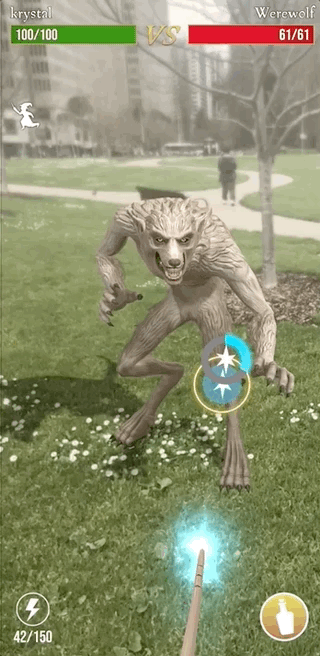 It’s similar in combat except you’ll also have to quickly cast protego when the enemy attacks you. That’s right, there are hostiles in this game! And although you can’t “die,” running out of stamina will fail the encounter or mission. More combat options open up later, though, as you’ll see. Encounters also vary in difficulty, which can be determined from the map or within the encounter — you may find some foes or rescues are beyond your power until you pump up a bit (or quaff a potion).
It’s similar in combat except you’ll also have to quickly cast protego when the enemy attacks you. That’s right, there are hostiles in this game! And although you can’t “die,” running out of stamina will fail the encounter or mission. More combat options open up later, though, as you’ll see. Encounters also vary in difficulty, which can be determined from the map or within the encounter — you may find some foes or rescues are beyond your power until you pump up a bit (or quaff a potion).
There are other little twists on the formula, though — the team said they have over 100 unique encounters, all fully realized in AR. And although you can only interact with them from a sweet spot that appears on the ground in AR, you can take your time to walk around or closely inspect the scene.
Foundables and confoundables and the other 20 things
Everything you’ll encounter is a foundable, and falls under one of numerous categories: magic zoology, dark arts, oddities, magical games and sports, Hogwarts, and so on.
And every foundable is listed in a sort of sticker book you’ll fill in bit by bit as you encounter them. Free Buckbeak however many times and it’ll be fully filled in, giving you various bonuses and, perhaps more importantly, the ability to take AR photos with the creature or character in question.
The creatures and characters range from common to very rare, of course, and you’ll need to get dozens of the former to fill in the book, but only one or a handful for certain plot-related items. They only shared the bare bones of the story, which will be revealed through in-game text and events, but a “deep, multi-year narrative arc” is promised. You can probably expect new foundables and ingredients and such to be added regularly.
One detail I found highly compelling was that weather, time of day, and even astral phenomena like moon phase will affect what you encounter. So for instance, werewolves may only come out on the full moon, while certain potion ingredients only appear (or appear more) when it’s raining, or in the evening. This kind of real-world involvement is something I’ve always appreciated and one that Niantic’s games are uniquely suited to take advantage of.
Potions will be necessary for healing and buffing yourself and others, so you’ll want to collect ingredients all the time; you mix them in a sub-screen, and can follow recipes or try your luck making something new.
One very cool thing they showed off that doesn’t really show well in images is a Portkey — you know, the objects in HP that transport you from here to there. It’s not exactly a canon treatment in the game, as they create portals instead, but it makes for a great AR experience. You put the portal down and literally step through it, then look around at a new scene (for instance, Ollivander’s shop or Dumbledore’s office) in which you can find items or presumably encounter monsters and other stuff. Portkey “Portmanteaus” are a bit like egg incubators in that you charge them up by walking, and can find or buy more powerful ones.
Min-maxing managed
What perhaps surprised me most in the team’s presentation of the various systems of the game was the extent of the stats and professions. There are three “professions,” they explained: auror, magical zoologist, and professor (“if you’re a bit of a goody-goody” — I resent that).
I figured these would be a bit like a play style bonus — one gives you more combat prowess, another is better for taming creatures, and so on. Boy, is there a lot more to it than that!
First of all, you should know that you have stats in this game. And not weird hidden ones or a relatively meaningless one like your trainer level in Pokémon GO. No, you have a straight-up stat screen filled with all kinds of stuff.
And your profession isn’t just a bonus or special ability — it’s a whole skill tree, and one to rival those of many a “serious” RPG.
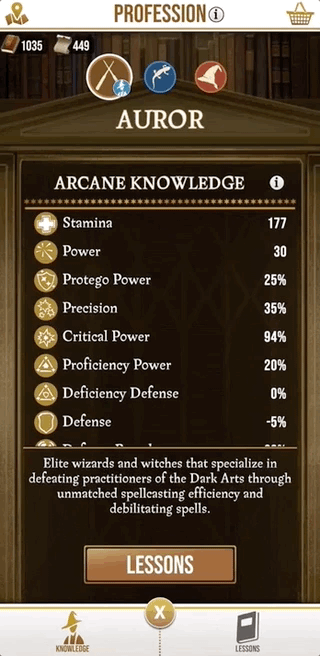 As in many other games, some nodes are simple things like an increase in stamina or spell power — some you can even upgrade several times to increase the effect. But others are entirely new abilities you’ll be able to use in various circumstances. I probed through a bunch in my limited time and found things that, for instance, healed allies, debuffed enemies, improved potion effectiveness, etc. These are definitely going to have a significant effect on gameplay.
As in many other games, some nodes are simple things like an increase in stamina or spell power — some you can even upgrade several times to increase the effect. But others are entirely new abilities you’ll be able to use in various circumstances. I probed through a bunch in my limited time and found things that, for instance, healed allies, debuffed enemies, improved potion effectiveness, etc. These are definitely going to have a significant effect on gameplay.
You can advance in any of the professions you want, however you want, though of course the further you progress down a tree, the more powerful abilities you unlock. You do this with tokens you earn from encounters, leveling, and challenges, so you get a steady trickle. It should take a good while to fill these out, though no doubt we’ll have some real tiresome types who’ll do it in a week.
Fortress of Jollitude
(It’s a portmanteau of solitude and jolly cooperation, because this is the teamplay part… let me have my fun.)
The last major aspect of the game is Fortresses. These are a bit like Gyms from Pokémon GO, in that they are multiplayer focused, but for now they’re strictly player vs enemy.
Fortresses are large, obvious locations on the map where you and up to four other players can join battle against a host of enemies in order to receive rare foundables and other rewards. How it works is that you and whoever else wants to play get within range of the Fortress and tap it. (They didn’t provide any images of one, inside or out, but you can see the roof of one just at the top left of the paw circle in the map image above.)
 You’ll then have a chance to join up with others by presenting a special item called a runestone. You’ll be getting these from normal encounters now and then or a few other sources, and there are 10 different kinds with multiple rarities — and depending on which you use, or which combination your team presents, the Fortress will have any of a variety of challenges and encounter types. (I only saw combat.)
You’ll then have a chance to join up with others by presenting a special item called a runestone. You’ll be getting these from normal encounters now and then or a few other sources, and there are 10 different kinds with multiple rarities — and depending on which you use, or which combination your team presents, the Fortress will have any of a variety of challenges and encounter types. (I only saw combat.)
This is where the combat complexity comes in, because all the enemies are presented to all the players at once, and you can take on whichever you choose. Have you leveled your magical creature taming? You better take on that hippogriff. Do extra damage against human foes? You’re on Death Eater duty. Stocked up on spells that hinder opponents or heal allies? You can use them from the select screen in real time, for instance if your friend is about to be knocked flat by a high-level Dementor and needs a hand.
I only got to test a small amount of this, but the possibilities for actual strategy and team synergy were very exciting, especially compared to the extended slugfests of Pokémon GO raids.
“Your forever Harry Potter game”
That’s how the team described Wizards Unite, and although a small-screen experience will never equal the immersion or magic (so to speak) of the cinema or the richness of the books, this does look like a dandy game and it will certainly be a heck of a time sink for countless players worldwide.
I only got to see a few minutes of the game in person, so there are parts I missed and parts that weren’t being shown; for instance, your Hogwarts house will likely figure later in multiplayer games, and more abilities are on the way.
I worry a bit that the simplicity and casual serendipity that defined Pokémon GO have been abandoned for a level of complexity that may be daunting for some. Yet at the same time I worry that the grind of collecting however many Buckbeaks you need to complete a page of the registry isn’t as satisfying as catching (and grinding up) a dozen Charmanders to power up your favorite ‘mon. And the AR experiences so far exhibit much visual variety but (that I saw) didn’t differ much from one another except in the trace you had to draw.
But there’s a great deal here and a great deal to like. It’s new, it’s fun, and it’s HP. I know I’m going to be playing.
(Lastly, the game will be released in the following languages: English, French, Italian, German, Spanish, Brazilian and European Portuguese, Polish, Russian, Swedish, Norwegian, Dutch, Danish, Turkish, Simplified and Traditional Chinese, Japenese, Korean, and Latin American Spanish.)
Niantic’s Harry Potter: Wizards Unite is a sorcerous smorgasbord for the Pokémon GO generation was first posted on https://techcrunch.com/gadgets/
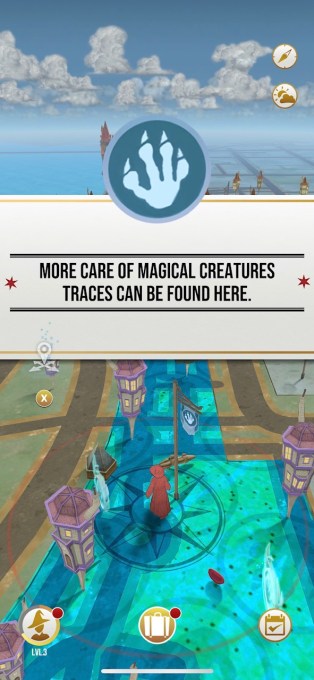
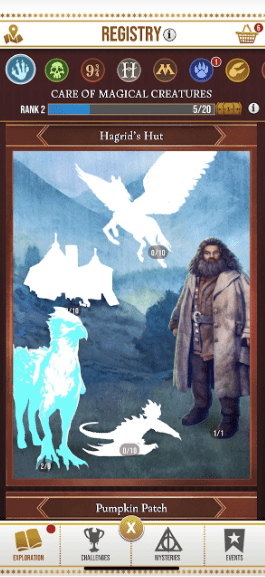
No comments:
Post a Comment